#Structural Integrity Philippines
Explore tagged Tumblr posts
Text
Building Fails Philippines – Part 2
Photo by Sami Aksu This weeks article is called building fails in the Philippines – part 2. As I mentioned in last week’s article, it is not to highlight foolishness but a collection of areas I need to think about when building your home in the Philippines. In most of my articles, I have talked about topics that are the “normal” way of building a home in the Philippines. In my mind, some of…
#Architectural Failures Philippines#Building Code Violations Philippines#Building Collapse Philippines#Building Disasters Philippines#Building Inspections Philippines#Building Regulations Philippines#Building Safety Issues Philippines#Building Safety Philippines#Construction Blunders Philippines#Construction Errors Philippines#Construction Failures Philippines#Construction Mistakes Philippines#Construction Oversights Philippines#Construction Quality Philippines#Engineering Blunders Philippines#Engineering Mistakes Philippines#Engineering Oversights Philippines#Philippines Building Fails#Structural Failures Philippines#Structural Integrity Philippines
0 notes
Note
I tried to bring this up in my seminary class and didn't get a great answer, but I feel like there's a weird relationship between missionaries and colonialism that's never been adequately addressed for me. I understand that people just want to bring the knowledge of the church to people but it usually feels really dismissive of the cultures already there.
Colonialism is about exerting control for the benefit of the colonizers. This can be in the form of settlers moving in and pushing out the existing population. Colonialism could be extracting resources and labor for the benefit & enrichment of the colonizing power.
That doesn't sound like what LDS missionaries do, so why would people think there's a relationship between missionaries and colonialism?
The "Three C's" of colonialism refers to Christianization, Commerce, and Civilization, which were justifications and strategies used by European countries to legitimize their colonial expansion and domination. Because religion was used as a way to justify colonization and to integrate the existing population into the colonizer's cultural control, there remains a link between the missionary work and colonization. Sending missionaries from wealthy, advanced nations, like the United States, to places which are less developed, like the Philippines, looks like colonialism where we are trying to save people of color from their ignorance and get them to adopt our religion and culture.
And let's not forget that the LDS Church has its own history of colonialism. Mormon pioneers settled in Utah where native tribes had been living for thousands of years. We took their land for our benefit. Brigham Young tried to replace the native people's understanding of themselves and their culture by preaching that the Book of Mormon contained their history and if they would convert they would become "white and delightsome," (in other words, white people were the norm and native people had to be changed to be like the whites). Even in recent history, the LDS Church operated the Indian Placement Program from 1954-1996, which had native people send their children to live in the homes of LDS members during the school year so the children could attend the nearby public schools. The program's goal was to "introduce Native Americans to mainstream values and social roles without demanding the abandonment of the old for the new" (Encyclopedia of Mormonism), in other words, to have the children adopt LDS & American values.
Is what LDS missionaries do today colonialism? There are some aspects which could be seen that way as we introduce people into an organization with a power structure which is flawed (see the restrictions placed on women & queer people or how English proficiency helps men advance in leadership) and is based on the American model of corporate governance. The LDS Church carries Western culture with it, such as in the hymns we have people sing all around the world and the instruments we allow to be played in our worship services. American missionaries often carry their culture into other parts of the world, like teaching members in other places about Halloween. We also ask converts to send 10% of their income to the Church, and that could be seen as extracting wealth from them.
While there are echoes of colonialism in our missionary efforts, it's hard to say that simply sharing our belief system with others in the hopes they'll join our faith qualifies as colonialism. The exchange of ideas is a normal part of modern life. Foreign media is translated for local viewing & reading, karate & yoga classes are offered around the world and we don't view that as colonialism since people are freely choosing these options. But given the history of using religion as part of colonizing others, we should be careful and sensitive to how we proceed. And more effort should be put into letting the LDS church adapt to local cultures.
39 notes
·
View notes
Text
Asian slaves, indigenous Americans, and identity in colonial era Mexico
The Spanish Philippines had a diverse slave population for local labor and export, including Filipino Indians [i.e. natives; indios], Muslim war captives (moros), and foreign slaves from as far away as Portuguese India.
… Upon their arrival, chino slaves [i.e. any Asian slave, not just Chinese] were absorbed by the urban economy of Mexico City, where they mainly worked as domestic servants or in textile mills (obrajes) … For their part, working in the city provided chinos with some possibilities for manumission. Chinos in domestic service were especially apt to embrace the limited opportunities available to them and to experience some social mobility. In the obrajes, chinos had few of the freedoms given to domestic servants, but they did benefit from government oversight of the industry. During official visits, chino slaves appealed for protection from overt exploitation by claiming that they were Indians (even if they were from Portuguese India). Remarkably, visiting inspectors listened to their complaints, and they often responded by liberating individual chinos under the assumption that they were indeed native vassals and could thus not be held in bondage. The overall experience of chinos in the viceroyal capital confirms the benefits of living close to the center of colonial power.
The presence of free indigenous immigrants from the Spanish Philippines in Mexico reinforced the idea that all chinos were Indians. The complex governing structure of colonial Mexico involved two republics or political communities (the república de indios and the república de españoles); this organization separated the indigenous majority from everyone else to facilitate the collection of tribute and the ministry of the Catholic Church … [N]ative immigrants from the Philippines purposely sought to confirm their membership in the Republic because corporate status provided personal advantages. They asked to be tallied in tribute rolls in Mexico to benefit from concomitant privileges, such as trading rights and legal representation through the General Indian Court. At the same time, free Filipinos were frequently confused with chino slaves - a situation that had serious consequences for Filipinos' relations with colonial institutions and enslaved individuals. Some immigrants resented having their indigenous identity questioned and sought to maintain a sense of their Indian-ness by keeping their distance from chino slaves. The majority, however, expressed solidarity with chino slaves. Filipino artisans, for example, took on chino slaves as apprentices and taught them marketable skills. Similarly, Filipino traders incorporated chinos into their own credit networks to facilitate self-purchase.
Individual chinos who were manumitted also embraced an Indian identity, regardless of whether they were from Goa, Macau, or other places in South and Southeast Asia. In this way, chinos challenged official attempts to define them solely as former slaves. Instead, they sought to join the free republic. The possibility for this kind of social integration caused widespread concern among slave owners. To defend their property rights, masters started to brand chino slaves on the face, rather than on the chest or arm as they did with Africans, in order to dissuade them from fleeing and "passing" as free Indians. This horrifying development shows that Indian communities welcomed runaway chino slaves and, by extension, that slave owners sought visible markers of their slaves' status.
Excerpt from the Introduction to “Asian Slaves in Colonial Mexico: From Chinos to Indians” (2014) by Tatiana Seijas
121 notes
·
View notes
Text
OPINION: DiliMall: Not a Mall for All

Photo credit: Lauren Nina Andres
For decades, the UP Shopping Center (SC) was a staple for the UP community. Filled with various stores from computer shops, school supplies stores, photocopying and bookbinding services, to food stalls, and beauty parlors, among others, the SC catered well to the needs of students, faculty, staff, and even residents of the campus. However, in 2018, the well-loved SC burned down, causing vendors to be displaced and its once affordable items and reliable services to no longer be easily accessible.
After the fire, the tenants experienced difficulties with relocating and rebuilding their establishments. According to an article by ABS-CBN, the University’s Business Concession Office drew lots for the affected business owners. Those that were picked were allowed to reopen in other locations on campus, such as Vinzon’s Hall, the Food Hub next to the Fine Arts Building, the Centennial Building, and the Acacia Building, among others. Some tenants were able to rebuild at the old tennis court nearby, provided by the administration as a temporary space, and others opted to reopen in Area 2. A month later, during the 1334th Board of Regents meeting held in April 2018, former UP President Danilo Concepcion announced plans for the rehabilitation of the SC into a more modern structure. And thus, “DiliMall” was born.
The move to rebuild and rebrand the SC as DiliMall was criticized by community stakeholders because the administration’s priorities seem to be misplaced as revealed in the proposed floor plan of the structure posted by the UP Diliman University Student Council (USC) last November 24, 2023. Robinsons Easymart and other known restaurants such as Mary Grace, Pancake House, and Army Navy take up the first floor, while the space given to UP vendors is found on the third floor. Not to mention, the vendors in the tennis court are at risk of being displaced once again since the space will be converted into a parking lot.
This begs the question of whether these “development plans” are truly for the benefit of the community or are merely ways for developers and businesses to capitalize on the university.
In light of this, last March 12, the “UP Not For Sale Network” was launched, consisting of various organizations namely, the USC, Shopping Center Association, UP Academic Workers Union, UP Workers Alliance, Movement for Democratic Governance, and Local College Councils. The network calls against the commercialization of DiliMall and pushes for the prioritizing of the UP Community.
DiliMall is not just the issue
DiliMall is not the first time the UP community has faced commercialization on campus. In an article by the Philippine Collegian, USC Councilor and Community Rights and Welfare Head Kristian Mendoza claimed that DiliMall is part of the implementation of the UP Master Development Plan (MDP), a land use policy approved by the Board of Regents in 2014 aiming to “proactively and systematically” develop UP’s land assets.
Before this, the UP Administration had already begun developing idle lands of the university, approving Ayala Land’s bid to convert 37.5 hectares of land into an information and technology hub in 2006—the UP Ayala Technohub.
The UP Integrated School (UPIS) community is familiar with this issue, as the old Grades 7-10 Building was replaced with the UP Town Center in 2013 by the same developer. From our 8-hectare land along Katipunan Avenue, we were moved to a building built and donated by the Ayala Corporation, a 5-structure facility with a main 4-story building, where the Narra Residence Hall once stood. The new 7-10 Building was budgeted at P180-million, from which P40-million was allotted for upgrades to the Grades 3-6 Building.
Only 10 years later, the Grades 7-12 Building is in a state of downfall, proving to be a great inconvenience and safety hazard to the UPIS community. During the Academic Year (A.Y.) 2022-2023, grades 3-12 students had to share the 3-6 Building since the structural integrity of the 7-12 Building was still being assessed. In A.Y. 2023-2024, although the 7-12 Building was cleared for use, parts of the building have been barricaded due to the degraded structure resulting in longer detours when moving from classroom to classroom and restricted movement among students, teachers, and staff.
The new Gyud Food Hub, which opened in December 2022, posed similar concerns as the development of DiliMall with failing to prioritize UP vendors that have long served the community. In this case, vendors displaced from the Main Library received a handwritten note from President Concepcion assuring them slots in the new facility. However, contrary to the administration’s promise, these vendors were not granted a space in the hub.
Moreover, the implementation of these establishments serves to exacerbate class disparity in the university by focusing on businesses catering to higher-income consumers that exclude students and lower-income community members. Again, the firms affected by the 2018 fire incident in the Shopping Center are still grappling with getting proper spaces allocated among them where established businesses have taken precedence over them.
Additionally, vendors and business owners are not the only ones being displaced by UP’s development plans, but as well as its residents. Homes and residences were demolished and claimed in accordance with the UP MDP. Some of the affected communities were Pook Village C, residents located at the UP Arboretum in 2020, and farmers from Pook Aguinaldo in 2021. These communities and families have been residing in the said areas for decades without any issues, only for them to be evicted from their homes; their livelihoods taken away to give space for “sustainable” infrastructure projects, without proper plans for relocation.
This further demonstrates how commercialization discriminates against marginalized individuals within the UP Community and society.
Additionally, the commercialization in UP Diliman may lead to the phase-out of small local businesses and vendors that have long been an integral part of the community. This greatly affects not only their livelihood but also the culture and diversity of the university’s environment.
Concerns and detractors from the UP community continue to rise towards this issue as stakeholders of the community are negatively affected and neglected by the university. Examples of affected sectors are dormitories, classrooms, and faculty buildings, all of which are experiencing problems with their space, functionality, and facilities.
It is important to maintain and improve the academic environments of UP as this will keep the university’s name, provide equal learning opportunities, liaise with the communities, and secure student wellbeing. These areas are fundamental in the institution for they facilitate learning and contribute towards its success as a top-ranked higher learning institution. To uphold the eminence that characterizes UP, we need to give priority to the conservation and upgrading of academic spaces.
Commercialization for who?
The university insists that converging with the private sector is beneficial as income generated from these rented spaces can be directed to academic and community needs. However, based on the 2016 audit report by the Commission of Audit, it is revealed that Ayala Land Inc. has 209.2-million pesos worth of unpaid obligations to UP. The amount comprises underpayments in rent income and late interest payments for the spaces at UP Technohub and UP Town Center. This raises the question as to why the university continues to commercialize its land when the previous corporation failed to keep up with its lease agreements.
Nevertheless, the university is still in dire need of other means of income. Government funding shortages can be pointed as to why the university insists on commercializing its land assets. Despite the fact that UP’s 2024 budget increased by P508-million, amounting to P24.771-billion this year, 80% of the funds were allocated for the university’s infrastructure projects. Sectors such as utility and maintenance incurred a P1.3-billion cut, and the budget for university operations was reduced for the new budgetary focus. According to an article by the Philippine Collegian, even if the funds for infrastructure were excluded, UP still suffered a P873-million cut. Additionally, P943-million will be cut for the provision of higher education services—which may result in fewer resources allocated to quality education for students. Taking all of this into account, it can be understood why commercialization may appeal to UP—as the university is getting increasingly pressured by almost all sides of its community to take action for its funding shortfalls.
Even so, our integrity as a public education and service institution must come first. It must be emphasized that UP serves as the nation’s model for quality education, and when we allow commercialization and privatization to be fostered within our institution, it may invite other educational institutions in the country to also be dependent on for-profit provisions. Reinforcing this notion, the presence of privatized businesses as stakeholders in the university may greatly influence university decisions, academic programs, and student policies.
In the end, UP must decide between prioritizing the community's interests or pursuing commercialization at the expense of its constituents. However, we’ve experienced the effects of this firsthand: the building we’ve sacrificed for profit forced us to settle for our current building–one that is deteriorating, crumbling piece by piece. We must ask ourselves: are we going to let this happen again? If the university chooses to commercialize its spaces for funding, attention, and care for its students and community must still be sustained.
Therefore, we need to oppose the commercialization of spaces and services in our university, assert our right to quality basic academic spaces and student facilities, stand with the vendors, employees, and families affected, and call on the administration to negotiate better terms with business partners—terms that put the benefit and interest of the UP community first. Furthermore, it is important to stress the need for more funding from the government to be able to run UP’s essential activities and programs successfully. We should come together to protect the good name of our institution and meet its responsibility to the UP community and the Filipino people.
// by Kela Alcantara, Grace Gaerlan, Xia Mentes
Sources:
Abello, L. T. (2024, February 6). UP students protest increasing commercialization of campus spaces. Philstar.com. https://www.philstar.com/headlines/2024/02/07/2331536/students-protest-increasing-commercialization-campus-spaces
Abello, L. T. (2024, March 12). UP community on ‘DiliMall’ opening: ‘Do not commercialize the services to the people’. Manila Bulletin. https://mb.com.ph/2024/3/12/up-community-on-dili-mall-opening-do-not-commercialize-the-services-to-the-people-1
Chua, C. (2022, July 6). UP’s Proposed 2023 Budget Set to Fund DaniCon’s Infra Splurge in His Last Year in Office. Philippine Collegian. https://phkule.org/article/586/ups-proposed-2023-budget-set-to-fund-danicons-infra-splurge-in-his-last-year-in-office
Daduya, J. (2023, January 28). “Nabudol kami!”: UP’s small-time vendors cry foul over Danicon’s unfulfilled promises.https://csspsinag.wordpress.com/2023/01/28/nabudol-kami-ups- small-time-vendors-cry-foul-over-danicons-unfulfilled-promises/
Gavilan, J. (2018, March 8). From photocopying services to Rodic’s: What’s inside UP Shopping Center. Rappler. https://www.rappler.com/newsbreak/iq/197714-things-to-know-up-diliman-shopping-center/
Gonzales, I. (2016, February 25). Ali reviews COA findings on unpaid obligations to UP. Philstar.com. https://www.philstar.com/business/2016/02/02/1549017/ali-reviews-coa-findings-unpaid-obligations-up?fbclid=IwAR2xWm74RVI8zYPn3EHJ9eUw0jaLyj3TMVziHv6i9RFSKZuwoHnDfz-zZsU
Lara, R. (2018). Decisions of the Board of Regents 1334th Meeting, 6 April 2018. The University of the Philippines Gazette, 49(3), 23-24. https://osu.up.edu.ph/2018/04/1334/
Lirio, A. (2023, December 24). An increase with setbacks: A look into the UP System’s 2024 budget. Tinig ng Plaridel.
7 notes
·
View notes
Text

NASA postpones X-59 flight tests to 2024
Fernando Valduga By Fernando Valduga 10/20/2023 - 10:01am in Technology
NASA postponed the first flight of the X-59 low-noise supersonic demonstrator to 2024, after a series of subsystem problems found during verification tests at Lockheed Martin's Skunk Works facility in Palmdale, California, later this summer, proved more difficult to solve than expected.
"We want to fly as early as possible, but we want to fly safely," says the agency, which - together with Lockheed Martin - has solved a variety of problems of abandonment and redundancy of security systems in various subsystems.
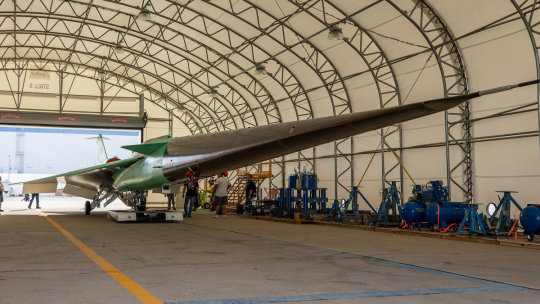
First reported in August, the problems are related to the flight control computer and the hydraulic system and were found during structural coupling tests in Palmdale. The coupling tests were designed to evaluate the interaction between the fuselage and the flight control system, and to ensure the absence of any aeroelastic and aeroservoelastic instabilities.
Developed by Lockheed for NASA's Quiet Supersonic Technology (QueSST) program, the X-59 almost 30 meters long was originally supposed to fly in 2021. However, the latest system-related delays add to a series of delays that included workforce hiring issues, the pandemic and technical challenges related to cabling and the integration of final systems. Until recently, the agency still expected to make the first flight of the X-59 by the end of the year, with a transition soon after to NASA's neighboring Armstrong Flight Research Center at Edwards Air Base for subsequent expansion of the envelope.

Commenting on the delay, NASA states: “This unique experimental aircraft requires unique and complex engineering, and its team encountered several technical challenges last year. The X-59 is currently in the process of integrated testing, which must be completed to help ensure safe and successful flights. NASA plans to release a more specific schedule for the first flight when the flight readiness review is completed, after integrated tests."
The X-59 is designed to collect community response data on the public acceptability of reduced sonic rons. The data will be used by U.S. and international authorities to determine whether a growth standard can be established that allows the release of the current ban on civilian supersonic flights over land, which has been in force since the 1970s.
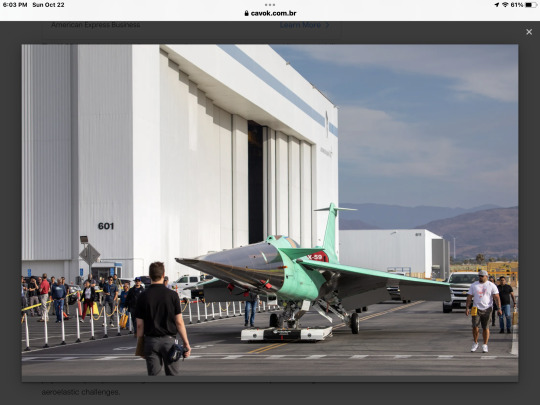
However, to achieve low-intensity sonic sonic roning at the projected speed of the X-59 of Mach 1.4, the aircraft is configured with a well-sloping hang glider and swinging extended nose section that represents more than one third of the length of the vehicle. Specifically designed with rigidity for high-speed testing, rather than resistance for payload capacity, the long and slender format therefore presents significant aeroelastic challenges.
Source: Aviation Week
Tags: Lockheed MartinNASAQueSST - Quiet Supersonic TechnologyTechnologysupersonic flightX-59
Sharing
tweet
Fernando Valduga
Fernando Valduga
Aviation photographer and pilot since 1992, has participated in several events and air operations, such as Cruzex, AirVenture, Dayton Airshow and FIDAE. He has work published in specialized aviation magazines in Brazil and abroad. Uses Canon equipment during his photographic work in the world of aviation.
Related news
MILITARY
Philippine Air Force acquires Lockheed C-130J-30 Super Hercules aircraft
19/10/2023 - 22:41
Bombardier solidifies its leading position in sustainable aviation and continues its work of defining the industry in the EcoJet research project, accelerating the second phase of testing.
TECHNOLOGY
Bombardier accelerates second phase of testing of the EcoJet research project
17/10/2023 - 16:00
Lockheed Martin received a contract from the U.S. Navy to build eight MH-60R helicopters Seahawk for the Spanish Navy. In the photo, a U.S. Navy MH-60R aircraft.
HELICOPTERS
Lockheed Martin receives contract to manufacture eight MH-60R Seahawk helicopters for the Spanish Navy
15/10/2023 - 20:05
HELICOPTERS
VIDEO: Airbus demonstrates single piloting joystick to replace three helicopter pilot controls
13/10/2023 - 13:00
Boeing ecoDemonstrator Explorer, a United Airlines 737-10, will fly in SAF, followed by NASA's DC-8 Airborne Science Lab measuring non-CO2 emissions.
COMMERCIAL
Boeing, NASA and United Airlines will test SAF benefits with flight formations of a DC-8 and a 737-10
13/10/2023 - 08:02
EVTOL
Boeing's Wisk Aero starts new flight tests with its eVTOL in Los Angeles
09/10/2023 - 11:00
10 notes
·
View notes
Text
Embracing Homeschooling on a Single Income: Our Journey with The Good and the Beautiful Curriculum
Hello, dear readers! Today, I want to share our story and how we have successfully embraced homeschooling despite living on a very low single income. If you're a low-income family considering homeschooling, I hope our journey with The Good and the Beautiful free curriculum will inspire and encourage you.
Our Homeschooling Journey
Life has not always been easy for us. With a single income, managing finances and providing for our family of seven has been a challenge. However, one thing my husband and I have always been passionate about is giving our children the best education possible. We believe in the value of personalized learning and the nurturing environment that homeschooling provides.
When we first started homeschooling, we were overwhelmed by the costs associated with various curriculums. Initially, our two eldest children were enrolled in Seton Home Study, which provided a very strong foundation in our Catholic faith. We are incredibly grateful to Seton for this, as it helped instill values and knowledge that continue to benefit our family today. However, as money became so tight, we had to stop enrolling them in Seton Home Study.
That's when we discovered The Good and the Beautiful curriculum, and it has been a true blessing for our family. The curriculum covers essential subjects like language arts, math, science, history, and art, with materials that are engaging and well-structured. It aligns with our values and provides a rich, character-based education that nurtures our children's minds and hearts. Despite using The Good and the Beautiful curriculum, we continue to use Seton materials, especially for Reading and Catholic Religion subjects. Thanks to our homeschooling friends here in the Philippines, who have shared their Seton materials with us, we can still incorporate these valuable resources. They are one of the many blessings we receive.
Success Stories: Our Two Older Kids
I am proud to share that our two older kids, who were homeschooled using The Good and the Beautiful curriculum, are now attending senior high school in a regular school setting. The transition was smooth, and they are thriving academically and socially. Their strong foundation in critical thinking, reading, and writing has set them up for success, and I credit much of that to the quality education they received through our homeschooling journey.
Continuing the Journey: Our Three Younger Kids
Currently, we have three children who are still homeschooling: a preschooler, a kindergartner, and a seventh-grader. Each of them benefits from the tailored approach of The Good and The Beautiful Currculum.
Our Preschooler: Learning through play and exploration, our little one is developing a love for learning from a young age. The curriculum's focus on character development and foundational skills is perfect for this stage.
Our Kindergartner: The engaging lessons and hands-on activities keep our kindergartner excited about school each day. The phonics-based approach to reading is helping build strong literacy skills.
Our Seventh-Grader: The rigorous and in-depth materials challenge our seventh-grader while fostering independence and critical thinking. The curriculum's integration of art and geography makes learning a joy.
Encouragement for Low-Income Families
I know firsthand how daunting the idea of homeschooling can be, especially when finances are tight. But I want to encourage you: it is possible. The Good and the Beautiful curriculum has provided our family with an invaluable resource, allowing us to educate our children at home without financial burden. Additionally, the strong foundation provided by Seton Home Study, which we continue to use in key subjects, has been invaluable.
Here are a few tips to make homeschooling on a low income work for your family:
Utilize Free Resources: Take advantage of free curriculum options like The Good and the Beautiful. There are also many online resources, libraries, and educational websites that offer free or low-cost materials.
Join a Support Group: Connect with other homeschooling families for support and resource-sharing. Many communities have co-ops, Facebook groups, or local meet-ups.
Be Flexible: Adapt your homeschooling schedule and methods to fit your family's unique needs. Remember, homeschooling allows for flexibility, so find what works best for you and your children.
Stay Positive: Focus on the benefits of homeschooling and the precious time spent with your children. Celebrate the small victories and progress along the way.
Final Thoughts
Homeschooling on a low income is not only possible but can be incredibly rewarding. With dedication, creativity, and the right resources, you can provide your children with a rich and meaningful education. The Good and the Beautiful curriculum has been a lifeline for our family, and the strong foundation from Seton Home Study continues to guide us. I hope our story inspires you to take the leap and embrace homeschooling, no matter your financial situation.
Thank you for joining me on this journey. Together, we can support and uplift each other as we navigate the beautiful world of homeschooling.
Disclosure: I do not receive any monetary compensation or other benefits from The Good and the Beautiful for writing this blog post. The opinions and experiences shared are entirely my own and based on my personal journey with homeschooling my children. My intent is to provide encouragement and support to other families who may be in similar situations.
#philippines#catholic#homeschool#trad wife#homeschooling#free curriculum#parenting#education#low income#low budget
3 notes
·
View notes
Text
why qualitative research matters to teaching (mathematics)


the pioneer cohort of ed.d. and ph.d. educ at ateneo gbseald with dr. ma. assunta "achoot" cuyegkeng / screengrabs from markkie aribon and lavi subang of ed.d.
-----
i told the internet about why i am where i am now in a previous post. now, i am ready to share what invaluable knowledge i've got from one of my courses so far.
during my undergrad and graduate studies, just pen and paper is mostly sufficient to create new ideas, problems, and solutions, and do research in math, but that's not the only concern i have with life and work.
for the past half a decade or so, peers and i saw a decline in the perceived quality of students in calculus at the university of the philippines los banos. what was supposed to be tackled in senior high school, like algebra, trigonometry, and precalculus especially for those from stem track, wasn't adequately done so. when introduced to fundamental calculus concepts, they do understand the notion of limit, how lines and derivatives intertwine and entangle, and why area is an integral, but when it comes to crafting solutions and answering problems, this inadequacy becomes apparent.
in turn, it becomes necessary for us to ask why this is the case? how do teachers influence their students' calculus learning and what are they doing to adapt? has existing policies done us (dis)service in the philippine (math) education? and, why is everybody and nobody at fault here?
just thinking about possible solutions is not enough. we need to get our hands dirty, wreck some established norms, and possibly hurt some feelings in the process. qualitative research, i learned, has some of the answers.
as i mentioned in a previous post,

for this course, i posed this question: how do teachers facilitate collegiate calculus learning through creative interventions?
in an attempt to answer this question, i had to look back at what is happening and what research tells us about calculus learning.
for one, most mathematics learning theories are based on existing ones from classical learning theories, like constructivism, positivism, and behaviorism. since the start of the 21st century, one of the main motivations of mathematics education research is rationalizing a theory for mathematics in consideration of its unique nature as a subject matter.
next comes becoming aware of challenges and factors in teaching and learning calculus, how do teachers intervene, and how important their role is.
as of yet, i think the question can't be answered by a simple survey, answered using a likert scale. we have to go on the ground and diligently ask calculus teachers and instructors in college the existing literature still resonate with the challenges they face and what they do about them in order to help their students. the quality of administration and prestige of the institutions they serve affect their students, but in reality, educators are at the frontline facing the students and implementing interventions as they go along day by day. their experience is a vital part of understanding the problem.
we should break down such a complex question into easily digestible and directly answerable ones that help us understand sac (structures-agency-culture): ask where the teachers come from, what kind of pool do they dive in to teach calculus, what restrictions they are put in, what the students are like, what they do to help the children [sic], and in what way do their interventions affect the students.
with the pisa results just released, now more than ever, we need to act as fast as we can to implement changes from the ground up.
why are we, everyone at school, so miserable in one way or another? this, i can definitely say, is my magnum opus.
i will die on this hill.
4 notes
·
View notes
Text
FMGE Coaching Classes in Delhi – Your Gateway to Success with Medway
For every Indian medical graduate returning from abroad, clearing the Foreign Medical Graduate Examination (FMGE) is the final and most crucial step toward obtaining a license to practice in India. Given the complexity and the low pass percentage of the FMGE, quality coaching becomes not just helpful—but essential.
If you're looking for FMGE Coaching Classes in Delhi that deliver results, mentorship, and motivation, Medway stands out as one of the top institutes for FMGE preparation.
Why FMGE Requires Specialized Coaching
The FMGE, conducted by the National Board of Examinations (NBE), tests the comprehensive knowledge of MBBS graduates from foreign universities. With only two chances a year and a rigorous 300-mark exam, the preparation must be strategic and well-guided.
Unfortunately, many students struggle due to:
Lack of structured revision
Weak conceptual clarity
Overwhelming syllabus
Poor time management
This is where Medway’s expert-driven approach becomes a game-changer.
Why Choose Medway for FMGE Coaching in Delhi?
At Medway, the focus goes beyond just delivering lectures. We build a complete support system that empowers you to understand, retain, and apply concepts effectively in the exam. Here's why Medway is the preferred choice of FMGE aspirants:
1. 📚 Expert Faculty from Across India
Medway brings together a team of highly experienced and result-driven faculty members from across the country. These are subject experts who specialize in FMGE/NEXT patterns and are known for:
Concept-based teaching
Smart revision techniques
Exam-focused approach
Whether it's Medicine, Surgery, Pathology, Pharmacology, or PSM, you’ll learn from educators who know how to simplify and reinforce complex topics.
2. 🎯 Structured Course Plans
Medway offers a range of courses to match your preparation needs:
Regular Batch – Full syllabus coverage with classroom teaching
Crash Courses – Intensive revision with high-impact sessions
Test & Discussion Series – Ideal for repeaters or revision-focused learners
Hybrid Model (Online + Offline) – Perfect for students outside Delhi
Each course is carefully designed to cover key subjects, high-yield topics, PYQs, and MCQ practice in a timely and effective manner.
3. 📈 Proven Results and Success Stories
Every year, Medway produces a growing list of successful FMGE candidates. Our students have come from a range of international universities—Philippines, Ukraine, Russia, China, Kyrgyzstan, and more—and consistently secure high marks and quick licensing.
Our alumni’s success speaks volumes about our commitment to excellence and personalized mentorship.
4. 📝 Comprehensive Study Material
Medway students receive well-structured notes, high-yield handouts, and access to past-year question papers, ensuring focused and efficient preparation. Additionally:
Regular quizzes and assessments keep you exam-ready
Clinical concept integration enhances application-based learning
Simplified diagrams and tables make revision easy
5. 💻 Mock Tests & Performance Analysis
Medway’s test series simulates the real FMGE environment with:
Full-length mock tests
Subject-wise tests
AI-based performance analysis
This helps identify weak areas, improve time management, and boost confidence before the big day.
6. 🧠 Doubt Clearing and Mentorship
We understand that FMGE preparation can be mentally exhausting. That’s why Medway ensures:
Personal attention from faculty
Live and recorded doubt-clearing sessions
Motivation and mindset training
We stand with our students—not just as teachers, but as mentors who care about your journey.
Prime Location in Delhi with Modern Facilities
Located in the heart of Delhi, Medway provides a well-equipped and student-friendly campus with:
Spacious classrooms
High-quality audio-visual learning aids
Online access for remote students
Clean, comfortable, and focused learning environment
Whether you attend offline or join from outside Delhi, the learning experience remains seamless.
Who Should Join Medway FMGE Classes?
✅ FMGE First-time Attempt Aspirants ✅ Repeaters seeking a better strategy ✅ International medical graduates from Philippines, Ukraine, Russia, China, etc. ✅ Students who want expert guidance, revision support, and test practice
Hear It from Our Students
🗣 “Medway was the best decision I made. The teachers made every concept easy to remember, and the mock tests were so close to the real exam.” — Ankur S., FMGE Jan 2025 Passout
🗣 “From lectures to doubt sessions, Medway made me feel supported throughout. I couldn’t have done it without them.” — Sana R., Kyrgyzstan Graduate
Contact Us Today!
Don’t leave your FMGE result to chance. Prepare with the best and give yourself the edge you need.
📍 Medway – FMGE Coaching Institute, Delhi 📞 Call: +91 9910556059 | +91 9910556361 🌐 Website: www.medwayedu.in
🎓 Crack FMGE with Confidence. Learn the Medway.
0 notes
Text
The Rise of International Franchise Opportunity in Philippines: A Guide for Global Brands
As globalization continues to shape the future of education, countries like the Philippines are rapidly emerging as high-potential markets for international academic institutions and edtech providers. With a young, educated, and English-speaking population, the country is ripe for educational innovation. Among the many business models being adopted, the international franchise opportunity in Philippines—especially in the education sector—is gaining serious traction.
For global education brands looking to expand into Asia, the Philippines offers a unique blend of market readiness, cultural compatibility, and long-term growth potential. This guide explores why the country is ideal for international education franchises and how forward-thinking institutions can make the most of this opportunity.
Why the Philippines Is an Attractive Market for Education Franchises?
1. High Demand for Quality Education
Education is a top priority for Filipino families. Even with limited income, parents are willing to invest in supplementary education, international programs, and certifications that offer a competitive edge. This demand extends across early childhood learning, K-12 support, test prep, language training, and professional upskilling.
2. Large Youth Population
More than half of the country’s population is under the age of 24. This massive demographic is not only actively pursuing academic growth but also adapting quickly to global education standards. With the government promoting universal access to education, there’s increased participation across all socioeconomic levels—creating room for various price-point franchises.
3. English Language Advantage
The Philippines ranks among the top English-speaking countries in Asia. This eliminates major linguistic barriers for global education providers and makes it easier to implement international curriculum models without significant localization issues.
4. Growth of Digital Learning
Online education is flourishing in the post-pandemic era, and Filipino learners have embraced hybrid and remote learning models. International franchises offering online modules, blended classrooms, or AI-driven learning systems are particularly well-suited for this tech-savvy market.
5. Government Support for Education and Franchising
The Department of Education (DepEd), Commission on Higher Education (CHED), and Technical Education and Skills Development Authority (TESDA) are increasingly welcoming global educational frameworks. Simultaneously, the Department of Trade and Industry (DTI) supports franchise-based business models—making it easier for foreign education companies to enter the market.
Key Segments in Education Franchising in the Philippines
The education industry is vast. Understanding which segments are ripe for franchising is crucial for success. Below are the most promising areas:
1. Preschool and Early Learning Centers
Early childhood education is a growing priority among Filipino parents, especially in urban centers. Franchises offering structured, play-based curriculums aligned with international standards are in high demand. Brands that also integrate STEM or bilingual education gain extra attention.
2. K–12 Supplemental Education
Tutorial services, after-school programs, and enrichment classes continue to grow. International franchises offering math, science, coding, or reading enhancement programs are well-positioned to thrive in this space.
3. Test Preparation and Language Training
Filipino students aspire to study abroad or secure jobs in multinational companies, fueling demand for IELTS, TOEFL, SAT, and GMAT prep. English language centers and academic coaching franchises with global reputations are welcomed by students and parents alike.
4. EdTech and Digital Learning Platforms
With improved internet connectivity and mobile-first users, EdTech franchises offering digital courses in coding, AI, entrepreneurship, or digital marketing can scale rapidly. Blended learning models that combine virtual sessions with local centers are particularly effective.
5. Professional Certification and Executive Education
Young professionals in the Philippines are eager to upskill, especially in fields like data science, AI, finance, project management, and business analytics. Global education brands offering short-term certification programs and internationally recognized credentials are gaining immense popularity.
Benefits of Entering the Philippine Education Market
Here are some of the unique advantages for international franchisors:
✅ Low Entry Barriers
Compared to markets like Japan or Singapore, the cost of entry into the Philippine education market is relatively low. Franchise fees, marketing expenses, and infrastructure costs are much more manageable, allowing global brands to scale faster.
✅ Favorable Franchise Laws
Franchise businesses in the Philippines benefit from clear and supportive regulations. Foreign investors can operate through master franchise agreements or joint ventures, depending on the business structure.
✅ Franchise-Friendly Culture
Filipinos are highly brand-conscious and tend to trust reputable, international names—especially in education. This brand affinity gives foreign educational franchises an edge over local competitors.
✅ Access to Southeast Asian Expansion
Establishing a successful franchise in the Philippines also serves as a strategic launchpad into neighboring ASEAN markets like Indonesia, Malaysia, and Vietnam.
Challenges to Prepare For
While the opportunity is immense, foreign franchises should be mindful of a few key challenges:
Local Curriculum Alignment: Some curriculum elements may need to align with DepEd or CHED requirements.
Cultural Relevance: Content and delivery methods should respect cultural values and student learning styles.
Partner Selection: Choosing the right franchisee or business partner is crucial to ensure brand integrity and operational success.
Pricing Sensitivity: While quality is valued, affordability remains an important factor for most Filipino families. Tiered pricing strategies may help reach broader segments.
How to Successfully Launch an International Education Franchise in the Philippines?
1. Conduct Local Market Research
Analyze regional differences in education demand. Metro Manila, Cebu, and Davao are popular starting points, but tier-2 cities are increasingly lucrative.
2. Choose a Scalable Model
Consider whether your model will be a single-unit franchise, master franchise, or area developer. Blended learning models with minimal capital requirements scale faster.
3. Build a Localized Brand Identity
Even if you’re a global brand, incorporating Filipino values and culture into your branding helps build trust and community engagement.
4. Invest in Teacher Training and Quality Assurance
Ensure that local educators receive comprehensive training to deliver your program effectively. Consistent quality control ensures sustainability and strong word-of-mouth referrals.
5. Go Digital with Marketing
Use digital marketing campaigns to reach tech-savvy students and parents. Social media, influencer marketing, and Google ads work well in this market.
Case in Point: Emerging Success of International Brands
Several international education brands have already found success in the Philippines. Their common factors? Local adaptability, strong franchisee partnerships, and alignment with global education standards. As the country becomes more integrated into global employment and education trends, these brands are well-positioned to lead.
Final Thoughts: Boston Institute of Analytics – A Model of Global Education Excellence
Among the growing international education brands making an impact in Asia is the Boston Institute of Analytics (BIA). With a mission to empower learners through industry-aligned training in data science, artificial intelligence, machine learning, and business analytics, BIA represents the future of global education.
What sets Boston Institute of Analytics apart is its hybrid delivery model, flexible certification programs, and practical, job-oriented curriculum. As professionals in the Philippines look to enter the global digital economy, institutions like BIA offer precisely what they need—world-class education with local accessibility.
For international brands seeking a franchise model that combines global reputation, technological innovation, and local relevance, Boston Institute of Analytics provides a compelling benchmark.
#Latest Franchise Opportunities In Philippines#Best Education Franchise In Philippines#Training Institute Franchise In Philippines#Edtech Franchisee In Philippines
0 notes
Text
Revolutionizing Trading Evaluations with Apex Trader Funding’s One Day to Pass,
In the competitive world of trading, adaptability and speed often separate successful traders from the rest. Apex Trader Funding has introduced a game-changing initiative, One Day to Pass Trading, that is transforming the traditional Day Trading Evaluation. By streamlining the funding process, this program allows traders to quickly access capital without enduring lengthy evaluation periods. This development is particularly significant for traders looking for Forex Funding and instant access to prop firm instant funding.
Transforming Trading Evaluations with One Day to Pass Trading
Traditional trading evaluations usually require several days or even weeks of consistent performance. While these methods test traders' discipline and strategies, they often delay access to live markets. For traders who thrive in fast-moving environments, these delays can mean lost opportunities. Apex Trader Funding addresses this challenge with its One Day to Pass Trading program, allowing traders to qualify for a funded account in just one day.
How One Day to Pass Trading Works
Streamlining the Timeline: Instead of waiting through extended evaluation periods, traders can meet their targets in a single session, accelerating their journey toward a Funded Account.
Maintaining Integrity: The program ensures that while the timeline is condensed, the evaluation process remains rigorous. Traders must still meet strict profit targets and risk management rules.
Empowering Experienced Traders: Skilled traders can leverage their expertise to quickly qualify for Forex Funding, eliminating unnecessary delays and maximizing market opportunities.
This innovative feature is setting new standards for Fast Trading Evaluation and is quickly becoming the preferred choice for Filipino traders looking for efficiency and flexibility in their funding process.
Why Choose Apex Trader Funding?
1. Speed Meets Opportunity
In trading, timing is everything. The One Day to Pass Trading Challenge Review confirms that Apex Trader Funding enables traders to transition from evaluation to live markets almost instantly. This is especially beneficial in Online Trading in the Philippines, where quick access to capital can determine a trader’s success.
Shortened evaluation times also alleviate psychological pressures, allowing traders to focus on strategy execution rather than prolonged waiting periods. This rapid yet structured approach ensures that traders who meet the criteria gain immediate rewards, positioning Apex Trader Funding in Philippines as a top choice for traders seeking prop firm instant funding.
2. Enhanced Focus and Motivation
Knowing that success depends on just one session encourages traders to refine their strategies and maintain discipline. This approach fosters:
Better decision-making under pressure
Stronger adherence to risk management principles
Sharper execution of profitable strategies
By promoting these essential trading habits, the Trader Funding Program not only accelerates access to capital but also helps traders build long-term success in competitive markets.
3. Competitive Edge in Fast Markets
With rapid access to trading funds, traders can seize opportunities in volatile markets without delays. This agility allows them to capitalize on price movements, react to global economic events, and optimize their trades efficiently. Additionally, access to a Funded Account in the Philippines through Apex Trader Funding provides an edge over competitors still navigating drawn-out evaluation processes.
Risk Management in a Condensed Evaluation Period
While the One Day to Pass Trading Challenge Review highlights its benefits, traders should be mindful of potential risks:
Avoid Over-Leveraging: The urgency to pass within a day might tempt traders to take excessive risks. Maintaining a balanced approach is crucial for long-term success.
Stick to a Proven Strategy: Success in Day Trading Evaluation in the Philippines requires strict adherence to a well-tested strategy rather than impulsive decision-making.
Manage Psychological Stress: Trading under tight deadlines can be intense. Emotional discipline and a calm mindset are key to navigating the process effectively.
Apex Trader Funding Review: Unlocking Local Opportunities
The increasing number of Filipino traders entering global markets highlights the need for localized solutions. Apex Trader Funding Review in the Philippines showcases the benefits of its tailored approach, ensuring traders in the region have the necessary resources to succeed.
1. Access to Global Markets
With Apex Trader Funding in the Philippines, traders gain access to major international markets, including forex, commodities, and indices. This connectivity allows traders to diversify portfolios and capitalize on global trends.
2. Convenient Local Payment and Support
Apex Trader Funding provides Trading Challenge in Philippines participants with localized payment methods and onboarding solutions, making it easier for Filipino traders to get started.
3. Resources for All Levels
From beginners to experienced professionals, Apex Trader Funding supports traders at every level. Those new to Online Trading in the Philippines can take advantage of educational resources, while seasoned traders benefit from faster access to capital through Fast Trading Evaluation.
Best Practices for Success with One Day to Pass Trading
To maximize the benefits of the One Day to Pass Trading Challenge Review, traders should follow these best practices:
Have a Clear Trading Plan: Define profit targets, risk parameters, and entry/exit strategies in advance.
Stick to Risk Controls: Avoid overtrading or taking unnecessary risks to meet the evaluation criteria quickly.
Prioritize Quality Over Quantity: Focus on high-probability trades instead of executing numerous low-quality trades.
Maintain Emotional Discipline: Keep emotions in check to ensure rational, well-thought-out trading decisions.
Assess Readiness: Before attempting How to Get a Funded Trading Account, ensure you have the skills and strategy required to meet the fast-paced challenge.
Is Apex Trader Funding Legit?
A common question among traders is, Is Apex Trader Funding Legit? Based on numerous Apex Trader Funding Review in Philippines discussions and trader feedback, the platform has established itself as a reliable and transparent funding provider. Its structured evaluations, clear guidelines, and trader-friendly policies make it a top choice for those looking for the Best Prop Firm for Filipino Traders.
Conclusion: The Future of Trading with Apex Trader Funding
The One Day to Pass Trading feature is reshaping the trading industry by providing a fast-track route to prop firm instant funding. Whether you're an experienced trader or just beginning your journey in Online Trading, Apex Trader Funding offers the resources, flexibility, and efficiency required for success.
By reducing evaluation times while maintaining high standards, Apex Trader Funding in the Philippines is empowering traders to take charge of their financial futures. Visit apextraderfunding.com today and experience the future of Day Trading Evaluation firsthand.
#apex trader funding in philippines#funded trading accounts in philippines#instant funding prop firm in philippines
0 notes
Text
Justice Reimagined: Glimmers of Hope in the Philippine Criminal Justice System
By: Eliana Glen Sarmiento

Does the Philippine Criminal Justice System still stand a chance? Is there any hope for it to improve and give what is due? The Philippine criminal justice system stands at a crossroads, grappling with deep-rooted challenges that have long hindered its effectiveness. Yet, as highlighted in Roy Panti Valenzuela's insightful report, "Glimmers of Hope," there are emerging developments that offer a beacon of optimism for meaningful reform.
For decades, the Philippine justice system has been beleaguered by issues such as prolonged hearings being postponed, overcrowded detention facilities, and a shortage of judicial personnel. These systemic problems have not only delayed the delivery of justice but have also eroded public trust in legal institutions. The adage "justice delayed is justice denied" resonates deeply in a context where many accused individuals languish in detention for years without trial.
A significant contributor to these challenges is the imbalance within the justice structure. While law enforcement agencies actively file criminal cases, there is a glaring deficit of judges, prosecutors, and public defense attorneys to process them. This bottleneck has led to human rights concerns, particularly in jails where overcrowding exacerbates the plight of detainees. Despite these daunting challenges, Valenzuela's report sheds light on promising initiatives aimed at revitalizing the justice system. One such initiative is the integration of Alternative Dispute Resolution (ADR) mechanisms. By facilitating the resolution of disputes outside traditional court proceedings, ADR has the potential to alleviate court congestion and expedite justice delivery.
Furthermore, legislative efforts are underway to introduce alternatives to imprisonment, such as community service and restorative justice programs. These measures not only aim to reduce prison populations but also focus on rehabilitating offenders and reintegrating them into society. Such approaches align with the broader goal of transforming the justice system from one that is predominantly punitive to one that is restorative and rehabilitative. While these initiatives are commendable, they underscore the need for a holistic approach to reform. Addressing the root causes of criminality, such as poverty, lack of education, and social inequality, is crucial. Investing in community development, education, and economic opportunities can serve as preventive measures against crime.
Moreover, enhancing the capacity of judicial institutions through adequate funding, training, and infrastructure development is essential. Ensuring that judges, prosecutors, and defense attorneys are well-equipped and sufficiently staffed can significantly improve the efficiency and fairness of the justice system. The journey towards a more equitable and effective justice system is a collective endeavor. It requires the concerted efforts of government agencies, civil society, legal professionals, and the broader community. By fostering a culture of accountability, transparency, and respect for human rights, the Philippines can pave the way for a justice system that truly serves its people.
In conclusion, while the challenges facing the Philippine criminal justice system are formidable, the "glimmers of hope" identified in Valenzuela's report offer a roadmap for transformative change. By embracing innovative approaches, addressing systemic issues, and committing to comprehensive reform, there is a genuine opportunity to build a justice system that upholds the principles of fairness, dignity, and human rights for all.
0 notes
Text
Watertight Doors Market Size, Share, Trends, Key Drivers, Demand and Opportunity Analysis
Watertight Doors Market - Size, Share, Demand, Industry Trends and Opportunities
Global Watertight Doors Market, By Product Type (Hinged Watertight Doors, Sliding Watertight Doors), Source (Hydraulic Watertight Doors, Electric Watertight Doors), Vessel (Commercial, Oil and Chemical Tankers, Bulk Carriers, General Cargo, Container Ships, Gas Carriers, Offshore Vessels, Passenger Ships and Ferries, Mega Yachts and Other Vessels, Military), Country (U.S., Canada, Mexico, Brazil, Argentina, Rest of South America, Germany, Italy, U.K., France, Spain, Netherlands, Belgium, Switzerland, Turkey, Russia, Rest of Europe, Japan, China, India, South Korea, Australia, Singapore, Malaysia, Thailand, Indonesia, Philippines, Rest of Asia-Pacific, Saudi Arabia, U.A.E, South Africa, Egypt, Israel, Rest of Middle East and Africa) Industry Trends.
Access Full 350 Pages PDF Report @
**Segments**
- **Product Type**: The watertight doors market can be segmented based on product type into sliding doors, hinged doors, and others. Sliding doors are widely used in maritime applications as they can provide efficient sealing properties in tight spaces. Hinged doors, on the other hand, are more traditional and offer sturdy construction for high-pressure environments. Other types of watertight doors may include vertically sliding doors or quick-acting doors for specific industry requirements.
- **Material Type**: Another crucial segmentation of the watertight doors market is based on the material type, which can include steel, aluminum, composite materials, and others. Steel watertight doors are popular due to their strength and durability, making them suitable for critical applications where structural integrity is essential. Aluminum doors offer a lightweight alternative without compromising on performance, making them ideal for applications where weight is a concern. Composite materials are gaining traction for their corrosion resistance and design flexibility.
- **End-Use Industry**: The market for watertight doors can also be segmented by end-use industry, including commercial shipping, naval vessels, offshore platforms, and others. Commercial shipping requires watertight doors for compartments to meet safety regulations and protect cargo in case of emergencies. Naval vessels use watertight doors to ensure the integrity of the hull and enhance overall security. Offshore platforms rely on watertight doors for protection against harsh marine environments.
**Market Players**
- **Damcos**: Damcos, a part of the Danfoss Group, offers a range of watertight door solutions for marine and offshore applications. With a focus on reliability and efficiency, Damcos provides advanced control systems for seamless operation of watertight doors in demanding environments.
- **Babcock Valves**: Babcock Valves specializes in manufacturing high-performance watertight doors for various industries, including marine and naval sectors. Their watertight doors are designed to withstand extreme conditions and provide reliable sealing properties for critical applications.
- **WThe watertight doors market is a dynamic and growing sector driven by the increasing demand for safety and security measures across various industries. One of the key segments in this market is the product type, with sliding doors, hinged doors, and other variants catering to different application requirements. Sliding doors are preferred for their efficient sealing properties in confined spaces, while hinged doors offer robust construction for high-pressure environments. The availability of other types like vertically sliding doors and quick-acting doors further enhances the market's versatility to meet specific industry needs.
Another significant segmentation factor in the watertight doors market is the material type used in their construction. Steel doors are widely favored for their strength and durability, making them a popular choice for critical applications where structural integrity is paramount. Aluminum doors provide a lightweight alternative without compromising performance, making them ideal for applications where weight considerations are crucial. The emergence of composite materials, with their corrosion resistance and design flexibility, is influencing market trends and expanding the range of options available to end-users.
The end-use industry segmentation of the watertight doors market highlights the diverse applications of these products across commercial shipping, naval vessels, offshore platforms, and other sectors. In commercial shipping, watertight doors are essential for compartmental safety and cargo protection during emergencies, ensuring compliance with stringent regulations. Naval vessels rely on watertight doors to uphold hull integrity and enhance security measures, emphasizing the critical role these products play in maritime operations. Offshore platforms benefit from watertight doors for safeguarding against harsh marine environments, underscoring the market's significance in ensuring operational safety and efficiency in challenging conditions.
In terms of market players, companies like Damcos and Babcock Valves are prominent names offering innovative watertight door solutions tailored to the marine and offshore industries. Damcos, as part of the Danfoss Group, focuses on providing reliable and efficient control systems for seamless door operation in demanding environments, catering to the evolving needs of customers. Babcock Valves, with its**Global Watertight Doors Market Analysis:**
- **Product Type**: - The product type segmentation of the watertight doors market plays a critical role in meeting diverse application requirements. Hinged watertight doors and sliding watertight doors are among the key segments driving market growth. - The demand for hinged watertight doors is driven by their sturdy construction, making them ideal for high-pressure environments where structural integrity is paramount. - Sliding watertight doors, on the other hand, are preferred for their efficient sealing properties in confined spaces, catering to maritime applications and industries where space optimization is essential.
- **Source**: - The source segmentation of the watertight doors market includes hydraulic watertight doors and electric watertight doors, offering varied options for control systems and operational efficiency. - Hydraulic watertight doors are known for their robust performance and reliable sealing properties, making them suitable for demanding marine environments. - Electric watertight doors provide innovative solutions for seamless operation and enhanced control, meeting the evolving needs of customers across different industries.
- **Vessel**: - The watertight doors market serves various vessel types, including commercial ships, oil and chemical tankers, bulk carriers, container ships, and offshore vessels, among others. - Commercial shipping relies on watertight doors for compartmental safety and cargo protection, driving the market growth in this segment. - Oil and chemical tankers, as
The Watertight Doors market research report displays a comprehensive study on production capacity, consumption, import and export for all the major regions across the globe. The target audience considered for this market study mainly consists of Key consulting companies & advisors, Large, medium, and small-sized enterprises, Venture capitalists, Value-added resellers (VARs), Third-party knowledge providers, Investment bankers, and Investors. This global market analysis report is the believable source for gaining the market research that will exponentially accelerate the business growth. The top notch Watertight Doors market report is the best option to acquire a professional in-depth study on the current state for the market.
Table of Contents: Watertight Doors Market
1 Introduction
2 Global Watertight Doors Market Segmentation
3 Executive Summary
4 Premium Insight
5 Market Overview
6 Watertight Doors Market, by Product Type
7 Watertight Doors Market, by Modality
8 Watertight Doors Market, by Type
9 Watertight Doors Market, by Mode
10 Watertight Doors Market, by End User
12 Watertight Doors Market, by Geography
12 Watertight Doors Market, Company Landscape
13 Swot Analysis
14 Company Profiles
Countries Studied:
North America (Argentina, Brazil, Canada, Chile, Colombia, Mexico, Peru, United States, Rest of Americas)
Europe (Austria, Belgium, Denmark, Finland, France, Germany, Italy, Netherlands, Norway, Poland, Russia, Spain, Sweden, Switzerland, United Kingdom, Rest of Europe)
Middle-East and Africa (Egypt, Israel, Qatar, Saudi Arabia, South Africa, United Arab Emirates, Rest of MEA)
Asia-Pacific (Australia, Bangladesh, China, India, Indonesia, Japan, Malaysia, Philippines, Singapore, South Korea, Sri Lanka, Thailand, Taiwan, Rest of Asia-Pacific)
Browse Trending Reports:
3D Display Market Anti-Acne Cosmetics Market Specialty Fuel Additives Market Spices and Herbs Extracts Market Biodegradable Tableware Market Resveratrol Market Bioservices Market Freight Management System Market Weight Management Diet Market Food Starch Market Freight Transportation Management Market Fourier Transform Infrared (FTIR) Portable Spectrometer Market
About Data Bridge Market Research:
Data Bridge set forth itself as an unconventional and neoteric Market research and consulting firm with unparalleled level of resilience and integrated approaches. We are determined to unearth the best market opportunities and foster efficient information for your business to thrive in the market. Data Bridge endeavors to provide appropriate solutions to the complex business challenges and initiates an effortless decision-making process.
Contact Us:
Data Bridge Market Research
US: +1 614 591 3140
UK: +44 845 154 9652
APAC : +653 1251 975
Email: [email protected]
0 notes
Text
Batch 2024 participates in 2-week off-campus internship
University of the Philippines Integrated School (UPIS) Batch 2024 completed their 2-week off-campus internship at various sites from February 12 to 23.
Part of the Grade 12 work program is the two-week off-campus internship which aims to apply the knowledge and skills they have obtained from Kindergarten to Grade 11, to experience a real-world work environment, to understand and explore the careers they may pursue in the future, and to develop proper attitudes regarding leadership structure, employee interactions, and professionalism.
Social Sciences and Humanities (SSH) Track
Grade 12 - Kalayaan, the Social Sciences and Humanities (SSH) track, had their work immersions at Bantayog ng mga Bayani Foundation, Interactive Children’s Literacy Program (ICLiP), M&P Creatives, and Teatrong Mulat ng Pilipinas. UP Diliman Information Office (DIO) and DZUP 1602, despite being within the UP campus, were also included as internship sites for the off-campus work immersion.
The sites offered internship tasks such as writing articles, creating scripts, designing social media posts and publicity materials, covering events, newscasting, hosting, observing and teaching classes, assisting video shoots, joining rehearsals, and participating in activities conducted by the sites.
Zaeda Wadi, a former UPDIO intern, shared some of the most important lessons she learned through her internship. “At the UP DIO, I learned that being attentive is such a helpful asset to have! Be it in article-writing, observing during programs, interacting with others, or following instructions, having a present mind makes things clearer—and easier. I also realized that there are various activities in UP Diliman that I can participate in! It opened more doors for me to venture that can set me on new experiences as a student and community member,” she stated.
Additionally, she talked about some of the discoveries she made through UP DIO. “UP DIO staff taught me that in the hustle of life, sharing conversations and laughs makes the office life bearable and memorable! I learned from their close bond how it is always nice, even essential, to check in daily wholesome chats with people we meet at the workplace,“ she shared.

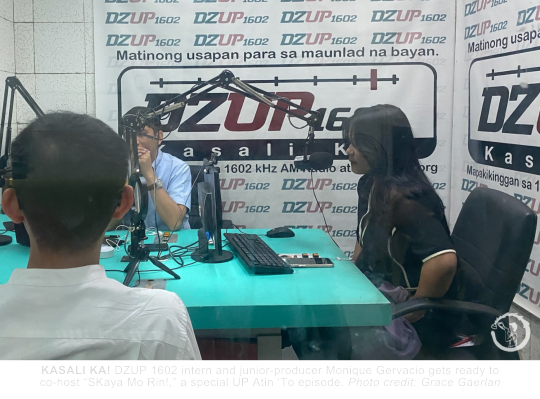
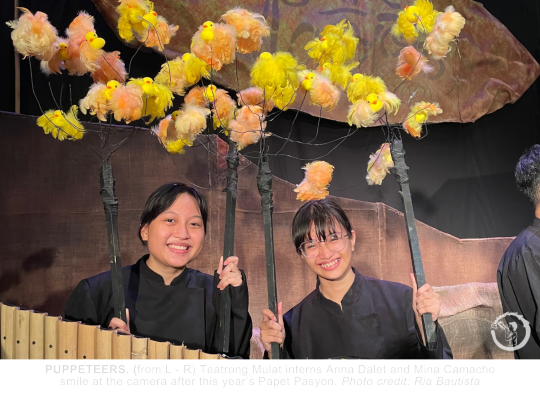
Business and Entrepreneurship (BE) Track
Grade 12 - Kapayapaan, the Business and Entrepreneurship (BE) track, experienced working at Underdog Fitness PH, Revised Salon, Friuli Trattoria, Puff & Dough BakeLab, SGD Coffee, Street Kohi, Noki Japanese Fried Chicken, and Urban Chick for their off-campus internship.
Some of their work included taking orders from customers, cleaning and setting up the area, making orders and food products for the business, assisting in supply inventory, creating and designing social media posts, preparing financial reports, assisting in administrative-related tasks, and conducting market research.
Princess Tan, a former intern at Noki Japanese Fried Chicken, shared her thoughts on how different the off-campus internship is from completing regular coursework for classes. “The real world is less structured than the system in school. The tasks we had to do weren’t listed for us and weren’t taught to us from the very start to end. You are expected to learn the operations as you go through the work program. Additionally, mistakes would cost you more unlike in school where you’ll just get a deduction on your score,“ she said.
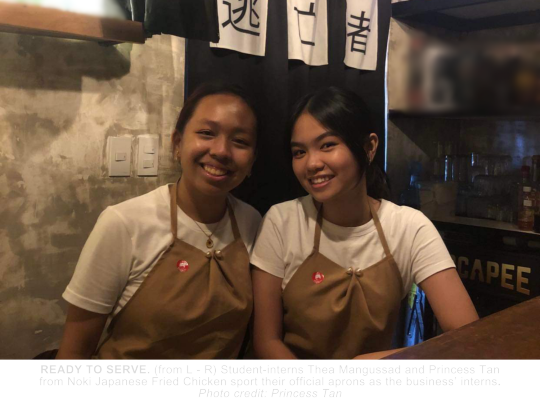
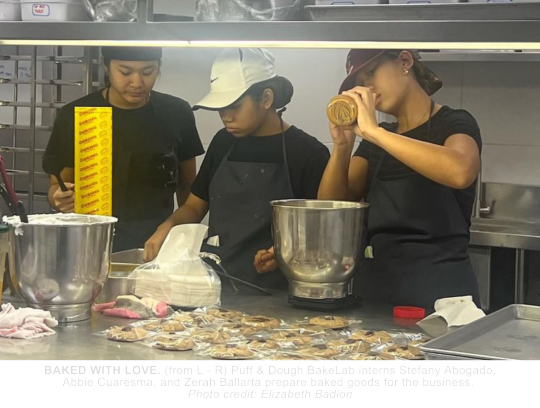

Applied Sciences and Engineering (ASE) Track
Grade 12 - Karangalan and Karunungan, the Applied Sciences and Engineering (ASE) track, held their internship programs at Ateneo de Manila University (ADMU) - Department of Information Systems and Computer Science (DISCS), ADMU - Department of Electronics, Computer, and Communications Engineering (ECCE), ADMU - Department of Mathematics, Buri Technologies, Department of Environment and Natural Resources (DENR) - Environmental Management Bureau (EMB), DENR - Mines and Geosciences Bureau (MGB), Department of Information and Communications Technology (DICT), Department of Science and Technology (DOST) - Advanced Science and Technology Institute (ASTI), DOST - Philippine Atmospheric, Geophysical, and Astronomical Services Administration (PAGASA), LCI Envi Corporation, New Era General Hospital, Smile Studio Dental, and Wilson Hobby Studio.
Some specific tasks given by the sites consisted of conducting playtests, exploring and programming with Artificial Intelligence (AI), attending workshops and seminars, testing websites, creating courses on websites, performing Test Case Documentation, listing products and packaging of companies, managing and operating with information and cybersecurity, weather research and reporting, assisting in dental-related work, input and documentation of dental procedures and prices, assisting in tech support with 2D software, 3D printing, and attending discussions and seminars held by the sites.
Enjoce Lampa, a former intern at ADMU - Department of Information Systems and Computer Science (DISCS), shared the skills he was able to develop or enhance through his experience. “The skill I used the most during the internship was definitely my knowledge in programming. I think I already had pretty good programming [or] coding knowledge from my experiences but this internship further enhanced my skills because I was able to use it on a real project. I learned the Godot game engine and its native language, GDScript, to create our game and I think I will be using this knowledge more in the future,“ he stated.
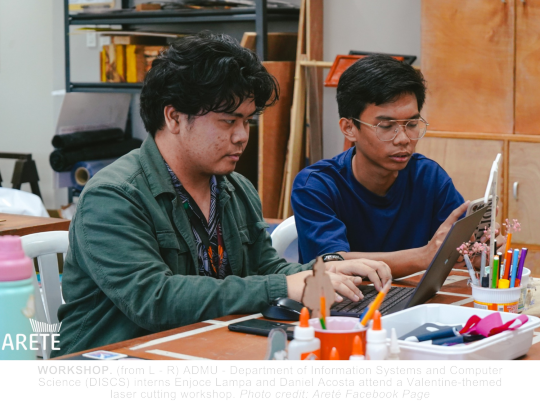

Batch 2024 is the first batch of Grade 12 students to experience separate cycles for their off-campus and on-campus internship since the pandemic. Last year, they finished their on-campus internship, which lasted from December 4 to 15. //by Mira Leaño and Ria Bautista
4 notes
·
View notes
Text

U.S. Navy starts investigation and releases images of the P-8 that sweeped the runway and stopped inside the sea in Hawaii
Fernando Valduga By Fernando Valduga 11/27/2023 - 10:16am Aeronautical Accidents, Military
The U.S. Navy will call an investigation into the November 20 accident in Hawaii, where a Navy's P-8A Poseidon reconnaissance and surveillance aircraft passed the end of the runway and ended up in Kaneohe Bay in Hawaii, authorities said, adding that the aircraft is structurally intact.
Three pilots, along with a crew of two officers and four soldiers, were on board the aircraft at the time, but no injuries were reported, authorities said. The Poseidon belonging to the 4 "Skinny Dragons" Patrol Squadron of Whidbey Island, Washington, was landing at Kaneohe Bay Marine Corps Air Station when, for undetermined reasons, the aircraft left the runway and entered the shallow bay just before 2 p.m. (local time for Hawaii). The weather at the time of the accident was cloudy and windy.
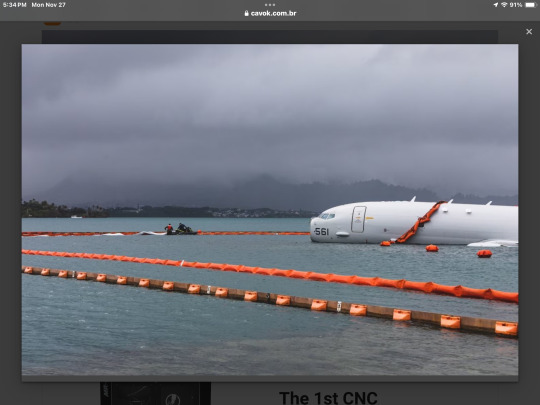
The P-8A Poseidon, based on the Boeing 737 plane, remained in the bay until Tuesday night.
“The U.S. Navy will call an investigation to determine the cause and factors that contributed to the accident,” San Diego-based U.S.-based 3ª Fleet officials said in a statement released Tuesday night.
The flight data recorder has already been recovered while the military continues to plan the removal of the aircraft.
The U.S. Navy Aircraft Accident Council is investigating the site at the Hawaii Marine Corps Base in Kaneohe Bay, trying to determine the cause of the accident and any factors that contributed. A hydrographic survey was carried out to evaluate the structural integrity of the P-8A plane.
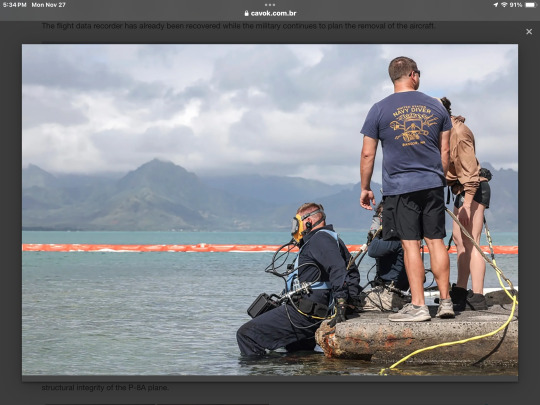
"The preliminary evaluation indicates that the aircraft is structurally intact and there are no signs of fuel leakage from the aircraft," they said. “More information will be released as soon as it is available,” the statement said.
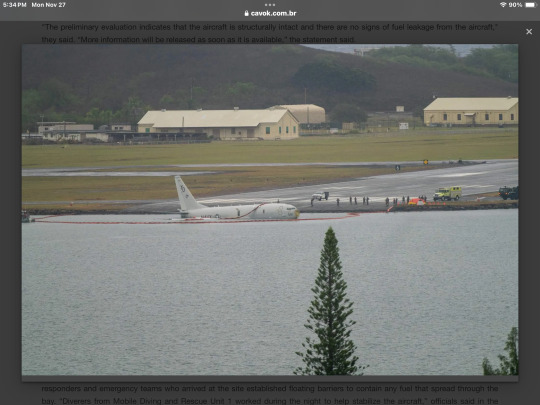
The aircraft ended up near the end of the runway, with its fuselage apparently floating in the sand and coral-covered bay. The first responders and emergency teams who arrived at the site established floating barriers to contain any fuel that spread through the bay. “Diverers from Mobile Diving and Rescue Unit 1 worked during the night to help stabilize the aircraft,” officials said in the statement.
Residents of Kaneohe Bay expressed concerns about possible damage to coral reefs and other potential damage caused by fuels or other chemicals in the area, which is about 2.4 kilometers from a former fishing spot.
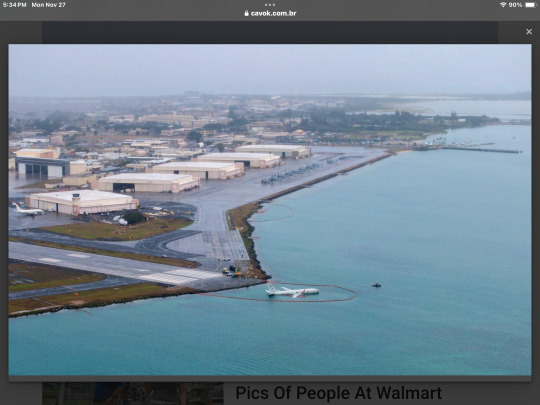
A response team was formed to deal with aircraft recovery, force protection and environmental issues, authorities said. This specially trained team monitors the area 24 hours a day.
Another Washington state crew, from the VP-40 "Fighting Marlins" squadron, arrived Thursday to take over the coverage of the internal defense, the Navy said.
Tags: Aeronautical AccidentsMilitary AviationP-8A PoseidonUSN - United States Navy/U.S. Navy
Sharing
tweet
Fernando Valduga
Fernando Valduga
Aviation photographer and pilot since 1992, has participated in several events and air operations, such as Cruzex, AirVenture, Dayton Airshow and FIDAE. He has work published in specialized aviation magazines in Brazil and abroad. Uses Canon equipment during his photographic work in the world of aviation.
Related news
HISTORY
AIRCRAFT CANCELLED: IML Addax
26/11/2023 - 22:22
MILITARY
Chinese fighters 'orbit' around Philippine Super Tucano aircraft during military exercise
11/26/2023 - 7:00 PM
MILITARY
Twelve things we know about the taxi tests and the first flight of the new B-21
11/26/2023 - 16:34
DEMONSTRATION SQUADS
Frecce Tricolori announces that it will make demonstrations in North America in 2024
26/11/2023 - 12:39
HISTORY
U.S. Navy celebrates 45 years of its first multifunctional aircraft
25/11/2023 - 20:45
ARMAMENTS
MBDA will integrate its missiles into KAI's KF-21 and FA-50 fighters
25/11/2023 - 14:42
7 notes
·
View notes
Text

Center Enamel can Provide Aluminum Dome Roofs for Philippines Crude Oil Storage Tanks
In the dynamic landscape of the Philippines' energy sector, ensuring the secure and efficient storage of crude oil is critical for national stability and growth. Shijiazhuang Zhengzhong Technology Co., Ltd. (Center Enamel), a global leader in tank solutions, is committed to contributing to this vital sector by providing state-of-the-art Aluminum Dome Roofs for the Philippines' Crude Oil Storage Tanks. This initiative aims to enhance the durability and safety of these essential energy reserves, strengthening the Philippines' energy security.
This project, designed to elevate the protection and longevity of the Philippines' crude oil infrastructure, aligns seamlessly with Center Enamel's mission to deliver innovative and reliable solutions. By leveraging our expertise in advanced materials and precision engineering, we are empowering the Philippines to safeguard its valuable oil reserves with robust, low-maintenance Aluminum Dome Roofs.
Center Enamel: A Global Leader in Tank Solutions – Delivering Unparalleled Excellence for the Philippines' Strategic Oil Reserves
Center Enamel has established itself as a global leader in the design, manufacturing, and installation of tank solutions, with a specialized focus on Aluminum Dome Roofs. Our reputation for unwavering quality, cutting-edge innovation, and steadfast commitment to customer satisfaction makes us the ideal partner for projects demanding the highest standards of performance and safety, especially within the demanding oil and gas industry.
Our comprehensive service portfolio encompasses every phase of the project lifecycle, from meticulous design and engineering to seamless fabrication and installation. Center Enamel's strict adherence to international standards and our unwavering dedication to providing durable and reliable solutions solidify our position as a leading provider of Aluminum Dome Roofs tailored for crude oil storage applications.
Aluminum Dome Roofs: The Pinnacle of Protection for the Philippines' Crude Oil Storage – Ensuring Unwavering Resilience and Reliability
For the Philippines' Crude Oil Storage Tanks, Center Enamel's Aluminum Dome Roofs offer the ultimate shield against environmental challenges, ensuring the sustained integrity of the stored crude oil. These roofs present numerous advantages over traditional steel or concrete alternatives, making them the optimal choice for this critical application:
Unmatched Corrosion Resistance: Aluminum's inherent resistance to corrosion renders it ideal for roofing systems in crude oil storage environments, where exposure to corrosive hydrocarbons and the Philippines' tropical climate is prevalent. This eliminates the need for frequent painting or repainting, significantly reducing maintenance and ensuring long-term durability.
Superior Structural Integrity: Our Aluminum Dome Roofs are meticulously engineered to withstand extreme weather conditions, including typhoons and heavy rainfall, ensuring the safe containment of crude oil. The lightweight yet robust design provides exceptional structural integrity and stability.
Enhanced Safety and Ventilation: The roofs are equipped with advanced ventilation systems to effectively manage hydrocarbon vapors and mitigate potential hazards. This ensures the safe operation of the storage tanks and protects personnel and the environment.
Minimal Maintenance Costs: Due to their exceptional corrosion resistance, our Aluminum Dome Roofs require virtually no maintenance throughout their operational lifespan. This translates to substantial long-term cost savings, making them an economically sound choice for the Philippines' strategic oil reserves.
Expansive Clear Span Capability: The lightweight properties of aluminum enable expansive clear span coverage, surpassing traditional materials like steel and concrete. This capability enhances design and functional flexibility for various tank sizes and configurations.
Rapid and Efficient Installation: Our Aluminum Dome Roofs are designed for swift and efficient installation, minimizing downtime and ensuring the timely completion of the project.
The Philippines' Crude Oil Storage Tanks: A Strategic Asset Fortified by Center Enamel's Aluminum Dome Roofs
The successful implementation of Center Enamel's Aluminum Dome Roofs in the Philippines' Crude Oil Storage Tanks will have a profound impact on the nation's energy security and environmental stewardship. By providing robust and reliable protection, our roofs will:
Ensure the Long-Term Integrity of Crude Oil Reserves: Our Aluminum Dome Roofs will safeguard the stored crude oil from environmental contamination and degradation, preserving its quality and value.
Enhance Safety and Prevent Environmental Hazards: The advanced ventilation systems and robust structural design will minimize the risk of hydrocarbon vapor buildup and prevent potential environmental hazards.
Reduce Maintenance Costs and Operational Downtime: The minimal maintenance requirements of our Aluminum Dome Roofs will significantly reduce operational costs and minimize downtime, ensuring the continuous operation of the storage facilities.
Bolster the Philippines' Energy Security: By providing reliable and durable protection for crude oil reserves, our Aluminum Dome Roofs will contribute to the Philippines' energy security and economic stability.
Center Enamel's Commitment to the Philippines' Energy Infrastructure
As a responsible provider of tank solutions, Center Enamel is committed to supporting the Philippines' energy infrastructure development. Our Aluminum Dome Roofs are designed to minimize environmental impact and provide long-term benefits to the nation's strategic oil reserves.
We recognize the importance of protecting the Philippines' natural resources and are dedicated to providing solutions that align with the nation's energy goals. Our Aluminum Dome Roofs contribute to safe and efficient crude oil storage, ensuring the long-term sustainability of the Philippines' energy sector.
Looking Ahead: Center Enamel's Enduring Partnership with the Philippines
Center Enamel is committed to fostering a long-term partnership with the Philippines, supporting the nation's endeavors to develop a robust and sustainable energy infrastructure. We are confident that our Aluminum Dome Roofs will play a pivotal role in safeguarding the Philippines' crude oil reserves and contributing to the nation's energy security.
Center Enamel: Your Trusted Partner for Aluminum Dome Roofs in the Philippines' Oil and Gas Industry
In conclusion, Center Enamel's expertise in providing high-quality Aluminum Dome Roofs for crude oil storage applications makes us the ideal partner for the Philippines. Our unwavering commitment to quality, innovation, and safety ensures that we deliver solutions that exceed expectations, safeguarding the environment and promoting sustainable development in the Philippines' vital energy sector.
0 notes